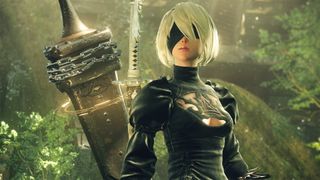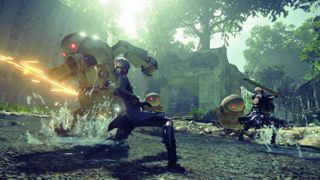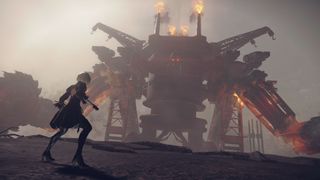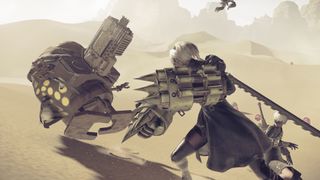The challenges of localizing Nier: Automata, one of the weirdest games ever made
A chat with localization studio 8-4 about translating one of Japan's oddest exports.

Boiled down to its essence, Nier: Automata is a game about slaying robots and looting their metallic corpses. It’s an action game—with skill unlocks and set pieces and scarcely a moment spent not in the heat of combat—but it’s also more than that. It’s a videogame where you’ll meet a friendly robot named after existentialist philosopher Jean-Paul Sartre, and defeat a boss inspired by philosopher Simone de Beauvoir. It’s a game you’ll need to play several times in order to “complete” properly, discovering new layers of depth and meaning, all while it switches between genres fluidly, almost ostentatiously. In other words—and as fans of Yoko Taro’s work will already know—Nier: Automata is a really weird videogame.
It’s also Japanese, which means for Western audiences, it carries the burden of both its inherent weirdness and its cultural differences. And that burden is no better understood than by John Ricciardi and Alan Averill, two of the brains responsible for Nier: Automata’s localisation at studio 8-4 (Ricciardi co-founded the company). While Japanese games often have intricately woven narratives and intimidatingly huge casts, the subtleties of the Nier series—its philosophical references, its sudden tonal shifts, its deliberate obscurity—make for a stiffer challenge.
“You don't often get to work on games where the overriding theme is ‘melancholy,'" Averill said. “But with the Nier series—especially the first game—that's the word we kept coming back to. The stories and characters are just so tragic and sad, and nailing that emotion is very difficult. Go too far and it's sappy, but don't go far enough and you suddenly strip the scene of its depth. The emotional stakes are always high in a Nier game, and the higher the stakes, the easier it is to fall from the tightrope and lose the audience entirely.”
What in the weird
But there’s also the inherent weirdness of Yoko Taro’s vision to contend with. The question I always grappled with while playing Automata was: how much of this is meant to be weird in Japanese? I asked Ricciardi how much of its strangeness can be attributed to Yoko Taro rather than the fog of translation.
“There are probably some aspects that are more uniquely associated with Japanese culture, which makes them feel a little ‘off’ to westerners,” he said. “But on the whole, I don’t think it’s all that different an experience for Japanese players. A bunch of stubby, garbage-can-esque robots coming together to form a giant egg that then hatches to produce a fully grown naked man who starts fighting you is going to be strange in any culture, I’m pretty sure.”
Fully grown naked men hatching out of makeshift robot eggs are strange, but it’s the subtleties of Nier’s characterisation that pose the greatest localization challenges. The two protagonists, 2B and 9S, are ostensibly emotionless YoRHa units—androids, in the world of Nier—and yet there’s a vast gulf between their temperaments. 8-4 had to convey these characters’ individuality while also making it clear that, in the end, their intelligence is artificial.
“This was something we discussed a lot when we were getting up and running on the project,” Averill said. “With 9S it was a little easier, because he's far more emotive in the Japanese to begin with. In fact, 2B is often telling him that emotions are prohibited, so if he was cold and emotionless, those lines would seem odd. We also needed him to be more perky in the beginning of the game to better contrast with the end when he's been changed by all of the events that happened to him. We settled into his personality pretty quickly, actually—he's kind, curious, and enthusiastic, but also restrained, if that makes any sense.”
The biggest gaming news, reviews and hardware deals
Keep up to date with the most important stories and the best deals, as picked by the PC Gamer team.
But 2B—as anyone familiar with the game already—was a pricklier subject to translate. Averill said the word “droll” was one they returned to as a guide for how 2B should be characterised. “The main motivating force of her character is her calm, collected nature, but we also knew that we couldn't make her a 100% emotionless robot or else the audience would never be able to connect with her,” Averill says.
“The idea isn't that 2B lacks emotion—it's that she keeps the emotions she already has under very close guard. So what we tried to do was tweak the dial of her characterisation just a notch so it moved from emotionless to droll. Yes, 2B is smart and in charge and nothing much phases her, but she still understands concepts like humor and love and so forth, even if she doesn't deploy them very often.”

Optimising the differences between these ostensibly “robotic” robot characters became quite granular. The duo had sticky notes all over their machines with lists of words that the game’s characters were, or were not, likely to ever say. Aiding the translation were also factors as small as the length of their spoken sentences: as you may have noticed, 9S will speak at length, in a questioning flowery tone, whereas 2B’s lines are short, clipped, terse.
Any time a historical figure is referenced in a game we work on, we’ll read up on them as much as we can to make sure we don’t miss anything key.
John Ricciardi
“She'll never use five words in a case where one will do,” Averill said. “So it was a constant case of writing lines for her and them cutting them back until you had the most efficient sentence possible.”
The question is, for people adept in both English and Japanese – and equally adept in their understanding of Japanese culture – would that dialogue have a different flavor? “If a guy has a regionally-specific accent in Japanese, for example, what's the best way to try and get that across,” Averill says by example. “Jersey mafia? Country bumpkin? British fop? You don't want every single character to fall neatly into a box, obviously, but you want to give the English player some kind of touchstone that they will be at least passingly familiar with if that same idea exists in the source language.”
“Another example is the super high-pitched whispery female character, which is something you encounter quite frequently in Japanese titles,” Averill continues. “That's a character type that has intrinsic meaning in Japanese – by which I mean people familiar with the culture will hear that voice and immediately recognise certain inherent traits of the character (i.e. youth, inexperience, kindness, naivety). But over here, that specific voice doesn't have the same effect – most of the time it just comes off as shrill and/or weak. So in cases like that, we aren't trying to 100% replicate the same voice as the Japanese, because in this culture, a different vocal type is actually going to end up being more true to the heart of the character. This isn't necessarily referencing any specific incident or character from Nier: Automata, but it's an example of the type of thing John's talking about when he says we sometimes veer slightly to have something make sense culturally.”

Android Existentialism
In addition to all this, the translation duo also needed to be mindful of Automata’s many references. While an exhaustive knowledge of, say, existential philosophy wasn’t necessarily required, Nier provides a challenge that few other modern videogames present: beneath the surface of the characterisation and narrative, what subtle intertextual clues are we missing?
“I did a bit of a deep dive into philosophy and philosophers while working on this game,” Averill said, “mostly to make sure that I wasn't missing some small reference that would otherwise slip by, or accidentally making one in the English that wasn't supposed to be there. It wasn't as extensive as I would have liked, of course—we didn't have time to read works in their entirety, plus a lot of it is pretty heady stuff—but I tried to look at online cliff notes and other bits of source material where I could.”
Ricciardi added: “Yeah, any time a historical figure is referenced in a game we work on, we’ll read up on them as much as we can to make sure we don’t miss anything key. In the case of Automata, aside from a couple of direct quotes here and there, there wasn’t too much we had to worry about. The first game referenced a lot of fairy tale characters and concepts as well, but besides having to make sure we didn’t miss any specific references, the rest wasn’t too challenging.”

But overall, Ricciardi says, the translation of a game like Nier: Automata doesn’t stray as far from the primary language as some might think. Indeed, for the first Nier, the English-language voices were recorded before the Japanese voices, indicating that Yoko Taro pays closer attention to the Western version of his games than perhaps other studios.
“Early on in the project, we were asked to avoid translating every line word-for-word and instead focus on natural dialogue that sounds right for Westerners, in particular because this was the 'Western' version of the game,” Ricciardi said. “Likewise, with Kainé’s frequent use of F-bombs [in the original Nier] and other colourful language, for example—Japan wanted her to have a foul mouth, so we obliged (and it wasn’t just for shock value—it makes sense once you come to know her backstory).
“But of course, all the dialogue in the game was based on the original Japanese or at least the Japanese intent—it’s not like we went and made up entire plot points or side stories or anything crazy like that.”
So yes, Nier: Automata is a very unusual videogame, and it’s not the fog of translation that made it that way. Yoko Taro has already guaranteed a place in the pantheon of bonkers game visionaries, but next time you play Nier, spare a thought for the translators that needed to make sense of it all.
Shaun Prescott is the Australian editor of PC Gamer. With over ten years experience covering the games industry, his work has appeared on GamesRadar+, TechRadar, The Guardian, PLAY Magazine, the Sydney Morning Herald, and more. Specific interests include indie games, obscure Metroidvanias, speedrunning, experimental games and FPSs. He thinks Lulu by Metallica and Lou Reed is an all-time classic that will receive its due critical reappraisal one day.
Most Popular



